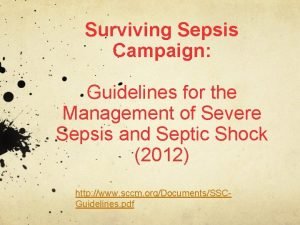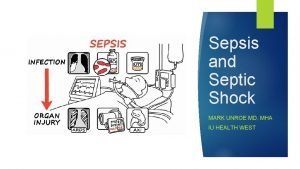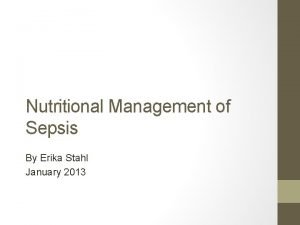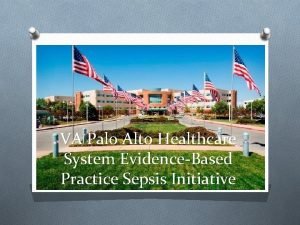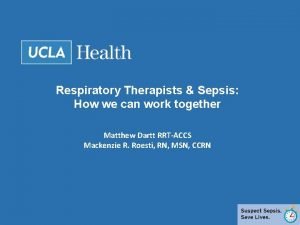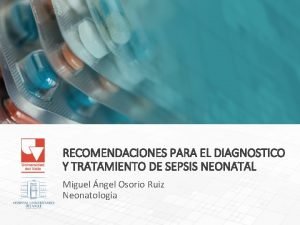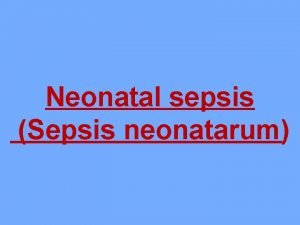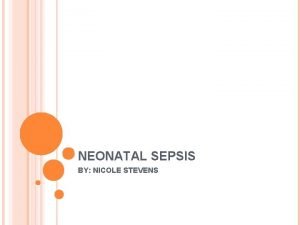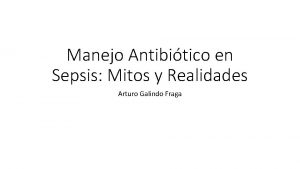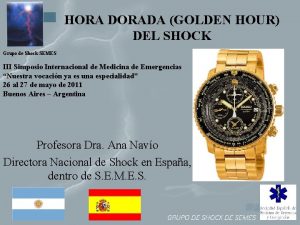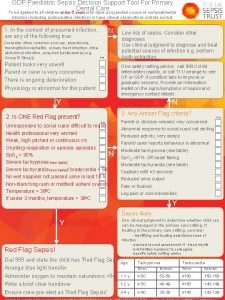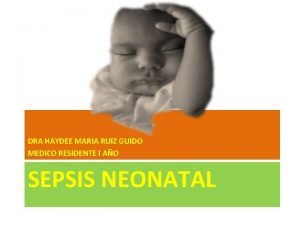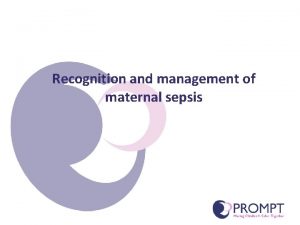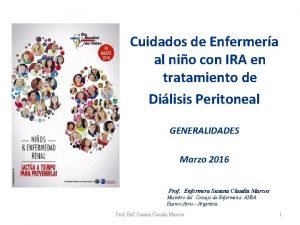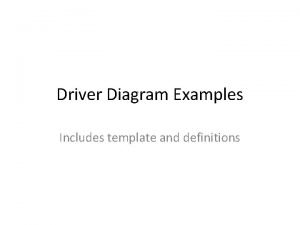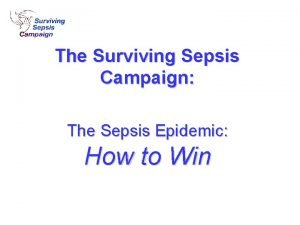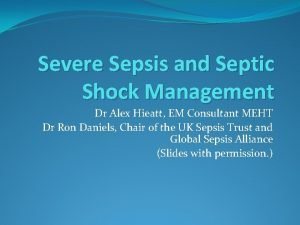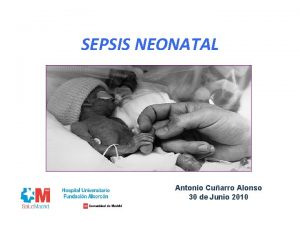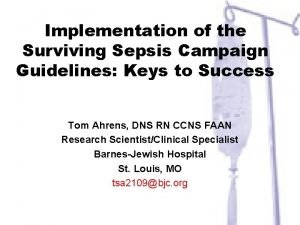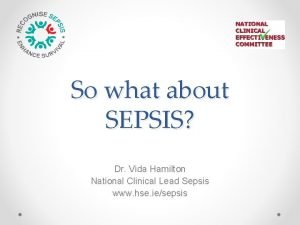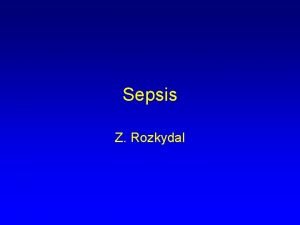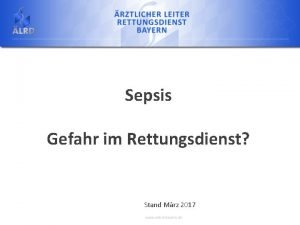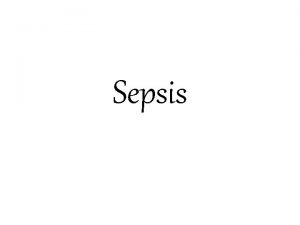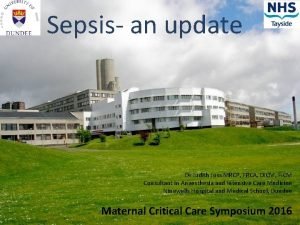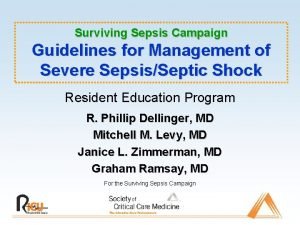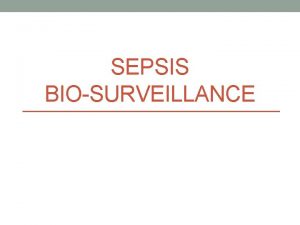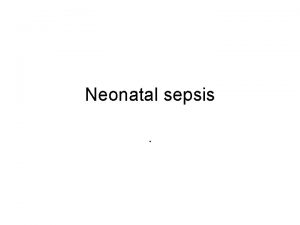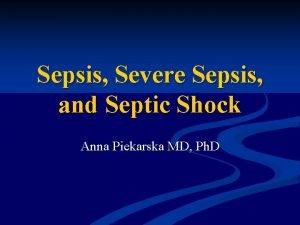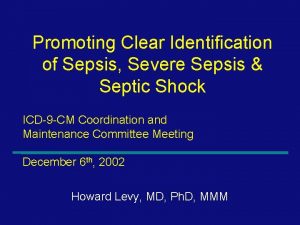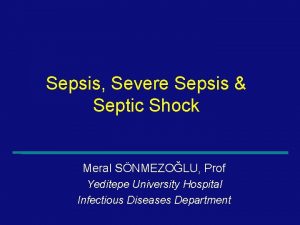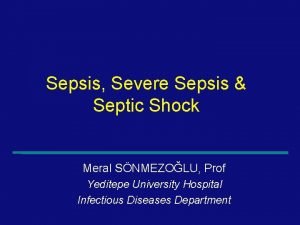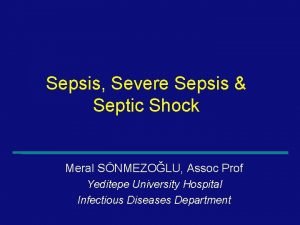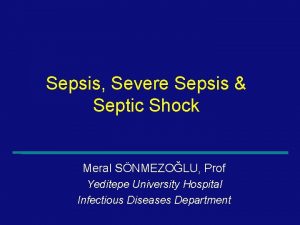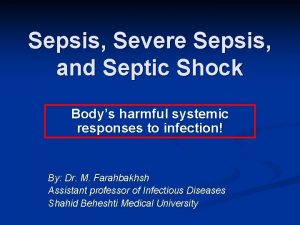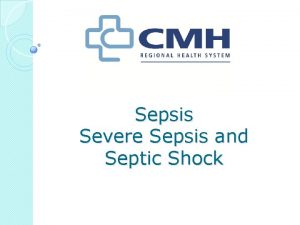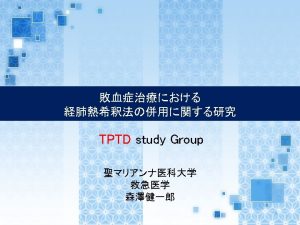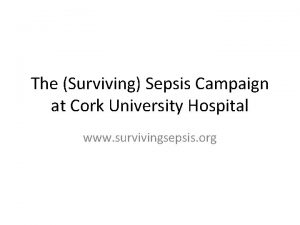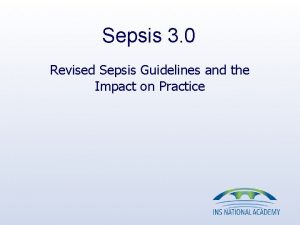Surviving Sepsis Campaign Guidelines for Management of Severe



































- Slides: 35

Surviving Sepsis Campaign Guidelines for Management of Severe Sepsis/Septic Shock CR 杜宜霖

Initial Resuscitation Ø In the presence of sepsis-induced hypoperfusion § Hypotension § Lactic acidosis

Initial Resuscitation Goals during first 6 hours: Ø Central venous pressure: 8– 12 mm Hg Ø Mean arterial pressure 65 mm Hg Ø Urine output 0. 5 m. L kg-1/hr-1 Ø Central venous (superior vena cava) or mixed venous oxygen [Sv. O 2] saturation 70% Grade B

Initial Resuscitation Goals during first 6 hours: Ø Central venous or mixed venous O 2 sat < 70% after CVP of 8– 12 mm Hg • Packed RBCs to Hct 30% • Dobutamine to max 20 g/kg/min Grade B

Diagnosis Ø Appropriate cultures Ø Minimum 2 blood cultures • 1 percutaneous • 1 from each vascular access 48 hrs Grade D

Antibiotic Therapy Ø Begin intravenous antibiotics within first hour of recognition of severe sepsis. Grade E

Antibiotic Therapy Ø One or more drugs active against likely bacterial or fungal pathogens. Ø Consider microorganism susceptibility patterns in the community and hospital. Grade D

Antibiotic Therapy Reassess antimicrobial regimen at 48 -72 hrs • • Microbiologic and clinical data Narrow-spectrum antibiotics Non-infectious cause identified Prevent resistance, reduce toxicity, reduce costs Grade E

Source Control Ø Evaluate patient for a focused infection amendable to source control measures including abscess drainage or tissue debridement. • Move rapidly • Consider physiologic upset of measure • Intravascular access devices Grade E

Fluid Therapy Ø Fluid resuscitation may consist of natural or artificial colloids or crystalloids. Grade C

Fluid Therapy Ø Fluid challenge over 30 min • 500– 1000 ml crystalloid • 300– 500 ml colloid • At least 20 ml/kg Ø Repeat based on response and tolerance Grade E

Vasopressors Ø Either norepinephrine or dopamine administered through a central catheter is the initial vasopressor of choice. • • Failure of fluid resuscitation During fluid resuscitation Grade D

Vasopressors Ø Do not use low-dose dopamine for renal protection. Grade B Bellomo R, et al. Lancet 2000; 356: 2139 -2143

Vasopressors Ø In patients requiring vasopressors, place an arterial catheter as soon as possible. Grade E

Vasopressors Vasopressin Ø Not a replacement for norepinephrine or dopamine as a first-line agent Ø Consider in refractory shock despite high-dose conventional vasopressors Ø If used, administer at 0. 01 -0. 04 units/minute in adults Grade E

Inotropic Therapy Ø Consider dobutamine in patients with measured low cardiac output despite fluid resuscitation. Ø Continue to titrate vasopressor to mean arterial pressure of 65 mm Hg or greater. Grade E

Inotropic Therapy Ø Do not increase cardiac index to achieve an arbitrarily predefined elevated level of oxygen delivery. Grade A Yu, et al. CCM 1993; 21: 830 -838 Hayes, et al. NEJM 1994; 330 -1717 -1722 Gattinoni, et al. NEJM 1995; 333: 1025 -1032

Steroids Ø Treat patients who still require vasopressors despite fluid replacement with hydrocortisone 200 -300 mg/day, for 7 days in three or four divided doses. Grade C

Steroids Optional: Ø Decrease steroid dose if septic shock resolves. Grade E

Steroids Ø Do not use corticosteroids >300 mg/day of hydrocortisone to treat septic shock. Grade A Bone, et al. NEJM 1987; 317 -658 VA Systemic Sepsis Cooperative Study Group. NEJM 1987; 317: 659 -665

Blood Product Administration Fresh frozen plasma • Bleeding • Planned invasive procedures. Grade E

Blood Product Administration Ø Platelet administration § Transfuse for < 5000/mm 3 § Transfuse for 5000/mm 3 – 30, 000/mm 3 with significant bleeding risk § Transfuse < 50, 000/mm 3 for invasive procedures or bleeding Grade E

Sedation and Analgesia in Sepsis Ø Sedation protocol for mechanically ventilated patients with standardized subjective sedation scale target. • • Intermittent bolus Continuous infusion with daily awakening/retitration Grade B Kollef, et al. Chest 1998; 114: 541 -548 Brook, et al. CCM 1999; 27: 2609 -2615 Kress, et al. NEJM 2000; 342: 1471 -1477

The Role of Intensive Insulin Therapy in the Critically Ill ØAt 12 months, intensive insulin therapy reduced mortality by 3. 4% (P<0. 04) In-hospital survival (%) 100 96 Intensive treatment 92 P=0. 01 88 Conventional treatment 84 80 0 0 50 100 150 200 250 Days after admission Adapted from Figure 1 B, page 1363, with permission from van den Berghe G, Wouters P, Weekers F, et al. Intensive insulin therapy in critically ill patients. N Engl J Med 2001; 345: 1359 -67

Glucose Control Ø After initial stabilization § Glucose < 150 mg/d. L § Continuous infusion insulin and glucose or feeding (enteral preferred) § Monitoring • • Initially q 30– 60 mins After stabilization q 4 h Grade D

Renal Replacement Ø Absence of hemodynamic instability § Intermittent hemodialysis and continuous venous filtration equal (CVVH) Ø Hemodynamic instability § CVVH preferred Grade B

Bicarbonate Therapy Ø Bicarbonate therapy not recommended to improve hemodynamics in patients with lactate induced p. H >7. 15 Grade C Cooper, et al. Ann Intern Med 1990; 112: 492 -498 Mathieu, et al. CCM 1991; 19: 1352 -1356

Primary Stress Ulcer Risk Factors Frequently Present in Severe Sepsis Ø Mechanical ventilation Ø Coagulopathy Ø Hypotension

Choice of Agents for Stress Ulcer Prophylaxis Ø H 2 receptor blockers Ø Role of proton pump inhibitors Grade C Cook DJ, et al. Am J Med 1991; 91: 519 -527

Consideration for Limitation of Support Ø Advance care planning, including the communication of likely outcomes and realistic goals of treatment, should be discussed with patients and families. Decisions for less aggressive support or withdrawal of support may be in the patient’s best interest. Grade E

Sepsis Resuscitation Bundle Ø Serum lactate measured Ø Blood cultures obtained prior to antibiotic administration Ø From the time of presentation, broadspectrum antibiotics administered within 3 hours for ED admissions and 1 hour for non-ED ICU admissions

Sepsis Resuscitation Bundle Ø In the event of hypotension and/or lactate >4 mmol/L (36 mg/dl): § Deliver an initial minimum of 20 ml/kg of crystalloid (or colloid equivalent*) § Apply vasopressors for hypotension not responding to initial fluid resuscitation to maintain mean arterial pressure (MAP) 65 mm Hg *See the individual chart measurement tool for an equivalency chart.

Sepsis Management Bundle Ø Low-dose steroids* administered for septic shock in accordance with a standardized ICU policy Ø Drotrecogin alfa (activated) administered in accordance with a standardized ICU policy *See the individual chart measurement tool for an equivalency chart.

Sepsis Management Bundle Ø Glucose control maintained lower limit of normal, but < 150 mg/dl (8. 3 mmol/L) Ø Inspiratory plateau pressures maintained < 30 cm H 2 O for mechanically ventilated patients.

Sepsis Resuscitation Bundle Ø In the event of persistent hypotension despite fluid resuscitation (septic shock) and/or lactate > 4 mmol/L (36 mg/dl): § Achieve central venous pressure (CVP) of 8 mm Hg § Achieve central venous oxygen saturation (Scv. O 2) of 70%** **Achieving a mixed venous oxygen saturation (Sv. O 2) of 65% is an acceptable alternative.
 Surviving sepsis definition
Surviving sepsis definition Dr mark a unroe
Dr mark a unroe Sepsis dietary management
Sepsis dietary management The ancient wonders of the world
The ancient wonders of the world Oldest surviving greek drama
Oldest surviving greek drama Wolfgang amadeus mozart was the only surviving
Wolfgang amadeus mozart was the only surviving Questions and answers about estuaries
Questions and answers about estuaries Hearth of folk culture
Hearth of folk culture It is the longest and greatest surviving anglo-saxon poem
It is the longest and greatest surviving anglo-saxon poem Surviving a flood
Surviving a flood The most ancient surviving seed plants are the
The most ancient surviving seed plants are the Mary ann cotton young
Mary ann cotton young Sepsis care near palo alto
Sepsis care near palo alto Neonatal sepsis pathophysiology diagram
Neonatal sepsis pathophysiology diagram Sepsis neonatal temprana y tardía
Sepsis neonatal temprana y tardía Neonatal sepsis
Neonatal sepsis L
L Sepsis
Sepsis Hora dorada emergencias
Hora dorada emergencias Gdp sepsis decision support tool
Gdp sepsis decision support tool Guido marcangeli
Guido marcangeli Sepsis 6 bundle
Sepsis 6 bundle Neonatal sepsis symptoms
Neonatal sepsis symptoms Neonatal sepsis nelson pediatrics
Neonatal sepsis nelson pediatrics Pae sepsis neonatal
Pae sepsis neonatal Sepsis bundle
Sepsis bundle Example of drivers
Example of drivers Sepsis hour 1 bundle
Sepsis hour 1 bundle Dr alex sepsis
Dr alex sepsis Antonio cuñarro alonso
Antonio cuñarro alonso Hemodynamics
Hemodynamics Give 3 take 3 sepsis
Give 3 take 3 sepsis Sepsis
Sepsis Sepsis
Sepsis Quick sofa
Quick sofa Sepsis criteria
Sepsis criteria
